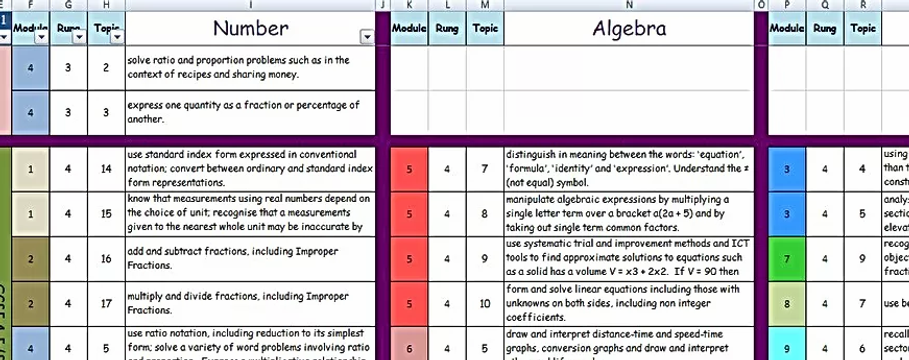GCSE Mathematics (Edexcel)
For Students
Revision
Teachers Documents
Scheme of Work Overview
The teaching content is split into 11 modules which can accessed via the drop down menus at the top of the page plus a wide range of proof based activities [Proof] and resources which should be integrated into the other modules.
Lesson resources can be found in the U Drive > Maths > 0 SOW > 1 GCSE Maths. From home, they can be accessed by turning on the St. Alban's VPN in Network settings on a staff laptop.
There are 4 progression ladders in Maths: Number, Algebra, Spatial and Data. Each ladder begins with the lower GCSE content on rung 1 and increases in difficulty as you move down the ladders. Foundation work is rungs 1 to 5 and the Higher content continues to rung 9.
The snapshot below shows part of rung 4 of the ladder and the module and content for each topic is displayed.
The ladder allows you to not only see the content you should be teaching but the content that has been covered earlier and which might need refreshing, as well as the content on the next rung if the ability of the group allows you to extend their learning within the module. It should be noted that a deep understanding of the target rung should be your objective and that students should not be extended too quickly at the expense of this understanding.
Student Progression Pathways
Each Mathematics group will be designated a rung they should be aiming to achieve throughout the year. So 7X1 will be covering work on rungs 3 and 4 of the ladder, with a focus on mastering the topics on rung 3 and the expectation that they will be on rungs 8-9 rungs in Year 11.
Medium Term Plan
The Scheme of Work is designed so that all classes are covering similar content at the same time, this is so that staff can discuss and share ideas both informally and within departmental meetings. Additionally it means that it will be less disruptive when students move from one set to another.
The SoW is designed so that the larger modules are covered at least twice during the year and there is a focus for starters to ensure that skills developed earlier in the year are interleaved so that they can be practised throughout the year. Year 7 students will complete a transition task before being placed into their classes and will follow the following program from Week 3 onwards.
Changes as of September 2021:
Exercise Books
Maths students have two books.
A blue book is used for exercises and tests completed in class and homework. Most teachers use the standard sized books (a little larger than A5) but some choose larger books (close to A4). Students should be encouraged to take responsibility for the presentation of their work remembering to include a date and title. It is often appropriate to encourage students to separate their pages into two columns to avoid wasted space.
A yellow or orange book is used as an Assessment Book.
Assessments
Every class will complete an assessment each half term. This will take place in the orange book with the assessment questions glued in too. Following every assessment, the students will complete a QLA feedback sheet to reflect on their successes and failures.
Assessments will be closed book, although 5‐10 minutes of revision time before an assessment may be appropriate. Relevant formulae may be displayed on the whiteboard at the teacher’s discretion. Each assessment will be the same for parallel groups. Marks will be sent directly to SK so that each student’s grades can be tracked centrally.
Following each assessment students should complete a follow‐up task for any weak topics. These will usually take place on Hegarty Maths as the relevant video number will be indicated on the feedback sheet.
Larger Tests
Larger tests will take place once or twice a year per year group. SATs papers will usually be used.
Recording Progress and Interims in Years 7-9
Each assessment will be judged against a GCSE progression pathway.
Pathway A (Accessing) expected to lead to a GCSE grade 1 or 2,
Pathway D (Developing) expected to lead to a GCSE grade 3
Pathway S (Secure) expected to lead to a GCSE grade 4 or 5
Pathway E (Exceeding) expected to lead to a GCSE grade 6
Pathway O (Outstanding) expected to lead to a GCSE grade 7, 8 or 9
So if a Year 7 student successfully understands rung 2 work their attainment will be recorded as an S to indicate the pathway they are on and when completing the interims home they will be given a Grade 4-5 which indicates their expected endpoint in Year 11.
Supporting Resources
There is an extensive collection of categorised resources stored centrally to support teachers as well as a Guide to each module with some selected approaches highlighted.
Praise Postcards
Each half term staff will be expected to put forward students for a praise postcard which will be given in recognition of their attitude and effort. They have been scheduled into the medium term plans to ensure that students receive the praise and recognition they deserve on a regular basis.




